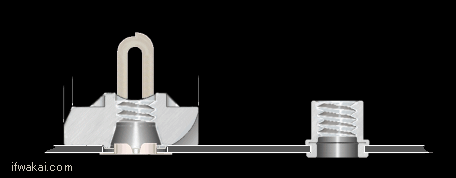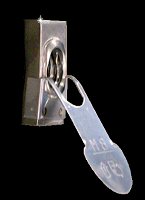| ifWAKAI |
F A Q
| Q1) How are INPULL NUT and TURNUT different
from the conventional rivet type nuts? A1) Due to some reasons including the fact that it is difficult to install welder nuts or plate nuts into hollow materials, our products and clinching nuts are being used for this kind of materials and each of them possesses features of its own.The following is the main differences of the two types of nuts. 1.Our products don't require special tools for riveting. If they are not used as parts for your products, any user can install them by only drilling a hole to insert the nuts as they require no special skills or tools. As at optional places (places in which it is not always necessary for nuts to be installed.), the nuts need not be installed wastefully, a lot of cost including lador cost on the assemble line can be saved. 2. Rivet type nuts gain holding power by riveting them to the base material. Therefore, structurally their holding power tends to be various or holding power won't increase after riveting and there is the possibility of them spinning togerther with the bolt. In case of our products, they are pressed hard against the base material with the frames supporting them while the bolt is being tightened resulting in the prevention of slipping of the nuts. 3.In case of clinching nuts, the part whose circumference is enlarged radially comes into contact with the wall of the hold in the base material by riveting. INPULL NUT and TURNUT are plate nuts that attach to the material with a wide plate and therefore, it won't deform much even thin base material but attach to them firmly. When it comes to price, however, they fall one step behind clinching nuts. Therefore, if there is no need for merits of cost reduction from reduced operations or prevention of nut spinning or of stronger holding power, clinching should be more economical.  left = TURNUT / right = clinching nuts |
| Q2) What is TURNUT made of and are there
any conditions for using it? A2) Raw material for the nut part of it is casting zinc. (The frame is made of AISI304.) The general characteristics of casting zinc include its inferiority to steel in terms of strength, the unavoidable existence of aeration during casting and its deteriorating flexibility at the extreme low temperatures of less than minus 20 degrees Celsius. Please note that it cannot be used in a corrosive environment as well as it cannot be used in any place or for the assemble of any structure where human life is put in danger. If excessive torque is applied to it during tightening, it might invite breakage of the bolt or damage to the nut. There are many applications for TURNUT such as in aluminum construction materials, doors, window frames, steel furniture and for fixing car parts, but we are recommending using INPULL NUT at places where especially high holding power is required. |
| Q3) Is there TURNUT made of stainless steel? A3) At present we don't have stainless steel TURNUT in our product line. INPULL NUT is a product all made of stainless steel which was developed in response to such a desire. The way of its use is different from that of TURNUT, but it boasts much higher strength and corrosive resistance. Therefore, we are recommending INPULL NUT at places where strength and corrosive resistance are demanded. (Please note that not only INPULL NUT but any bolts and nuts may rust even they are made of AISI304 in a very high corrosive environment.)  INPULL NUT |
| Q4) What is the difference between MECHA
NUT and TURNUT? A4) TURNUT was developed for use in thin base materials with 3mm or less in thickness (such as aluminum construction materials, steel furniture, moulded plastic products and car bodies.). Depending on size, it can be used in base materials with up to 6mm in thickness. At present the bolts to go with it are M4, M5, M6 and M8. MCHA NUT is quite different from TURNUT in that it was developed for use in industrail products using thick material of 10mm and more such as plywood, composite materials and honeycomb. The bolts to go with it are M6, M8 and W3/8. |
| Q5) The price of it seems a bit higher than
welder nuts, press nuts or clinching nuts? A5) As long as unit price is concerned, there is a diference between our products and welder nuts, press nuts and clinching nuts infavor of the latter. But if we take into consideration the total cost including costs other than the cost of the product such as labor cost for installation, you will feel sufficient merit in using our products for cost reduction. For instance, in case of welder nuts, if there happen burns or damage to decorative laminates, it will call for a lot of labor to deal with it. In case of clinching nuts, as you see in (A2) above, there are various inconspicuous factors in generation costs such as the purchase of tools, maintenance cost and the problem of both the nut and bolt spinning together due to lack of clinching of the nut. Of course, for those who have completely automated large scaled production lines, the merits of cost reduction and strength mentioned above may not be always what they ask for. Therefore, we would recommend such users the conventional welder nuts or press nuts. |
| Q6) Can we use common bolts for you products? A6) TURNUT, INPULL NUT and MECHA NUT can be all used with common bolts. There are several things you have to take heed of about bolts to be used. 1. Please refrain from using bolts with their surface treated with lubricant. It may produce high powar with low torque and break tha nuts. We recommend prior consultation if you try to use surface treated bolts called "such and such a coat". 2. We ercommend prior consultation if you try to use bolts coated with adhesive for preventing loosening. 3. Bolts of large shank diameter may not be used. Especially, the hole in the frame on TURNUT cannot accept bolts of large shank diameter as it is so designed to lead a bolt straigth ahead. It may be rare but please be careful about ths bolts plated thickly. There is no particular problems about bolts of small shank diameter. But in this case, as the threads don't engage firmly, it is something expected that the threads be broken with low torque. |
| Q7) Are special tools needed when a bolt
is tightened? Is there anything we have to
take care of when we do that? A7) We already explained in (A8) that you can use common bolts as they are. There is no need for specail tools when bolts are tightened. The thing that calls for your attention is that the nut is out of your reach and in a state of hanging a bit in the air waiting for a bolt. If a bolt is pushed forward strongly and turned forcefully with a tool as in the case of normal, there might occur improper engagement of the bolt and nut. After the nut is set, therefore, you should insert a bolt by hand and make sure that threads of the nut and bolt are engaged with each other properly and then turn the bolt with a tool. In case of unfamiliar operations, when a bolt is inserted, you should turn it once or twice in the reveres way while pushing it lightly. Then after you feel it secured comfortably, you should turn it clockwise while pushing it to engage the threads of the bolt and nut properly. (Even is you use our products as attached parts of your products, we recommend describing what is mentioned above in your instruction manual too.) |
| Q8) Can the tab on INPULL NUT be made small? A8) The tab of INPULL NUT is larger than that of TURNUT. But as the steps of inserting the nut in a hole by the tab and then pulling it has to be taken, we decided to adopt this design to make it easy to handle the tab at the expense of its small size. INPULL NUT was also developed with an eye to using it at places where high holding power is what is most needed. Generally speaking, if objects are fixed on thin plates with screws and bolts of M6 or M8 forcefully, base materials are pressed out shape as they are pulled. Therefore, most users cover the base materials with something like metal fixtures of large surface in order to avoid deformity due to pulling force at the time of tightening. The size of the tab on INPULL NUT is decided so that it is not as big as it cannot be hidden behind the cover such as metal fixtures of large surface. If the tab sticks out of the fixture to be fastened, please find a position in which the bent tab is hidden under the cover such as metal fixtures by changing inserting position of the nut. If you adjust the the position of INPULL NUT when inserting it into a hole acording to the nature of the object to be fasten, there seem to be no problem in most cases. If the matter of strength or corrosion is not so important, TURNUT can be used in places of small area. |
| Q9) INPULL NUT requires a hole larger in
diameter than the screw to be used. Is there
any problem concerning the alignment of the
screw after the screw is tightened? A9) There is no such problem occurring after the screw is tightened. As the nut has to be inserted from the front side to the back, it is unavoidable for a hole to be made larger in diameter than the screw. For that reason, a projection is formed on INPULL NUT and TURNUT at the place where the nut is in contact with the surface of the base material. The projection is designed to fit into the hole to prevent the screw from being deviated. (Please refer to the drawing of the introduction of our products. A projection is formed around the female threads.) Therefore, the screw or bolt to be used will go through the center of the hole without fail even the unt is used on upright walls as the projection fit into the hole. |
| Q10) Can INPULL NUT be used on the horizontal
surface like floor? A10) It can be used though some technique is required. In case of the vertical surface, as the tab is bent and stays put there, temporary fixing can be done without problem. But in caseof the horizontal surface, sometimes in may be difficult to fix the nut temporarily by only bending the tab. So, in this case, please use it by putting the tab in place with both side adhesive tape. |
| Q11) The tab of INPULL NUT is left between
the base material and fixtuer. Is space created
between them? A11) On drawing, a space of the thickness of the tab is supposed to be created. But the tab is design to be very thin with only 0.3mm. Therefore, in practice, it is thought to be within a permissible range. The head flange of TURNUT is also designed to be 0.3mm in thickness. |